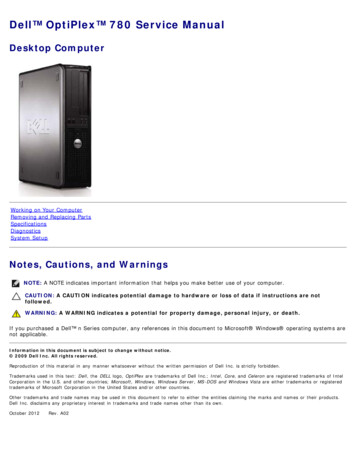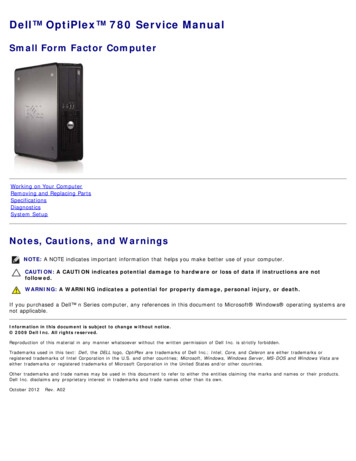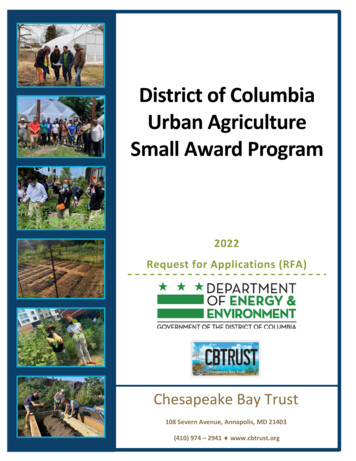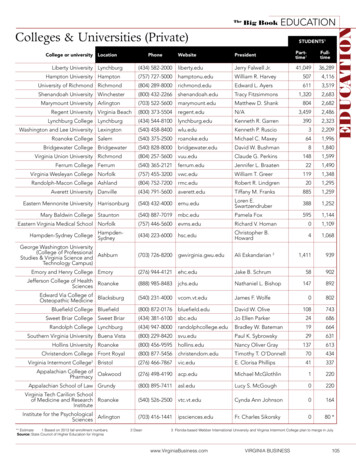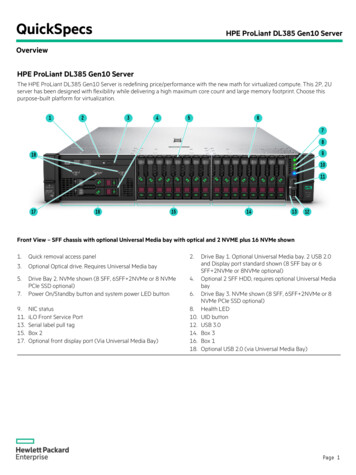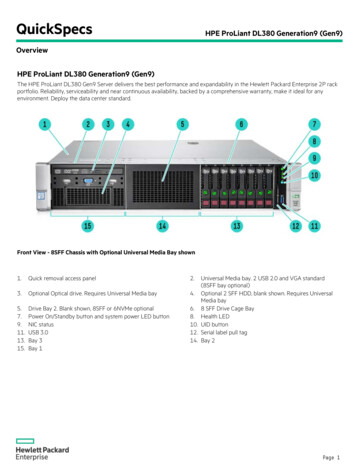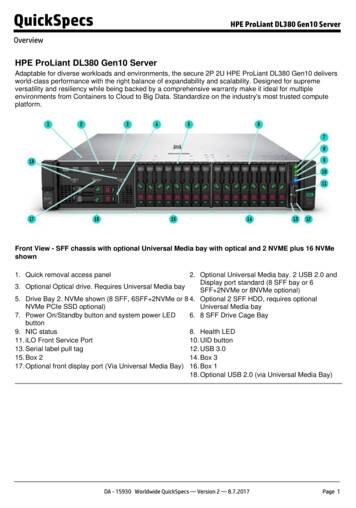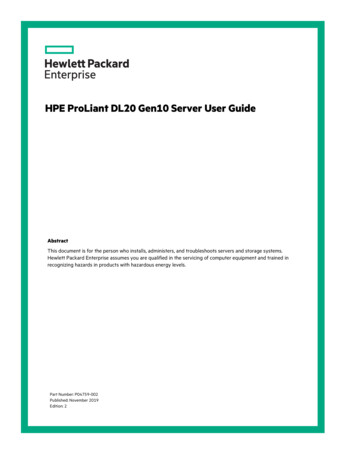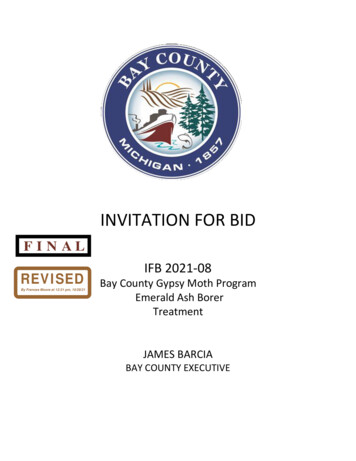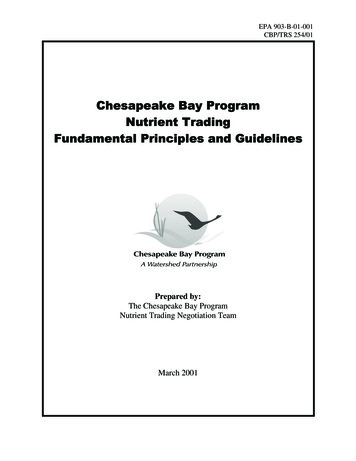
Transcription
EPA 903-B-01-001CBP/TRS 254/01 Prepared by:The Chesapeake Bay ProgramNutrient Trading Negotiation TeamMarch 2001
Printed for the Chesapeake Bay Program by the Environmental Protection AgencyRecycled/Recyclable – Printed with Vegetable Oil Based Inkson Recycled Paper 30% Postconsumer
Chesapeake Bay ProgramNutrient TradingFundamental Principles and Guidelines2001410 Severn Avenue, Suite 109Annapolis, Maryland etPrepared by:The Chesapeake Bay ProgramNutrient Trading Negotiation TeamAllison Wiedeman, Chesapeake Bay ProgramJulie Trask, Chesapeake Research Consortium
PREAMBLEThis document presents fundamental principles and guidelines for nutrient trading in theChesapeake Bay watershed. The Chesapeake Bay Program convened the Nutrient TradingNegotiation Team (Negotiation Team) in June 1999 for the purpose of exploring the feasibilityof nutrient trading for point and nonpoint sources in the Chesapeake Bay watershed and, ifappropriate, develop nutrient trading guidelines for the Bay jurisdictions to use on a voluntarybasis. The outcomes of the Negotiation Team’s deliberations are presented herein. Thisdocument is not a regulation. Rather, it is intended to be used on a voluntary basis as a guide forthose Bay jurisdictions that choose to establish nutrient trading programs.The Negotiation Team was composed of a wide array of interested stakeholders from across theChesapeake Bay watershed—Federal, state, and local governments, as well as municipal,industrial, agricultural, environmental, and public interests, were among those represented.Using a facilitated consensus-based approach, the Negotiation Team derived the nutrient tradingfundamental principles and guidelines found in this report. Fundamental principles represent theelements that the Negotiation Team deemed essential for an equitable, environmentallyprotective, yet viable, trading program. The guidelines are what the Negotiation Team deemsimportant for the jurisdictions to consider when developing and implementing a trading program.This document is a resource for the user in becoming familiar with, or developing andimplementing, a trading program for nutrients. The document is based on the NegotiationTeam’s comprehensive consideration of numerous other trading programs and approaches,substantial research, and corresponding lengthy negotiations. General guidance is provided inthis document: certain program details will need to be determined by individual Bayjurisdictions, should they implement a trading program. This document has undergone publicreview and revisions were made, according to public comment, where the Negotiation Teamdeemed appropriate.Should the signatory states pursue trading programs, the Negotiation Team recommends that thedefinitions, principles, and guidelines contained in this document be reevaluated two to threeyears after implementation and actual operation of such programs. A reevaluation shouldprovide the opportunity for trading programs to adapt as reduction goals change, new waterquality data becomes available, new technologies evolve, policies such as “smart growth” areimplemented, cap strategies are developed, and as tributary strategies are revised. Recognizingi
the importance of land use efforts such as “smart growth” in Bay restoration, the NegotiationTeam agreed,1) that if it can be established that trading only within a major Bay tributary substantiallyconstrains “smart growth” or cap strategy or tributary strategy implementationinitiatives, and2) that trading with an adjoining major Bay tributary would yield significant environmentalbenefits,then the reevaluation may include a close examination of Fundamental Principle #2* to considerthe potential for allowing trades across major Bay tributary boundaries. Any changes to thedefinitions, principles, and guidelines must be adopted through negotiation by consensus in amanner consistent with the adoption of the existing definitions, principles, and guidelines.*iiSee Exhibit 1.2 or Section 3.3 for a definition of Fundamental Principle #2.
HOW TO USE THIS DOCUMENTIt is important for the reader to understand that, due to the very complex nature of this subjectmatter, this document should be read in its entirety to fully comprehend how all of the facets of atrading program work together and to avoid the meaning of any individual facet from being takenout of context. For example, a reading of the fundamental principles alone will not provide all ofthe information necessary to accomplish trading. Rather, it is necessary to comprehensivelyconsider the fundamental principles together with the guidelines and supporting options herein todevelop a complete trading program.This document is not a regulation but a guide for the states to use on a voluntary basis whendeveloping their own trading programs. Certain words frequently associated with statutes orregulations (e.g., must, should, may, will, etc.) have been carefully used in this report to reflect ahierarchy of importance or strength of the feeling by the Negotiation Team. In this report, theNegotiation Team’s use of the words “must” and “will” reflect essential elements of a successfuland defensible nutrient trading program, the word “should” reflects the Negotiation Team’sstrong recommendation for inclusion of such elements in a trading program, and the use of theword “may” reflects optional elements that are worthy of consideration.Hierarchy of Language Chosen by the Negotiation Teamiii“Must”reflects what the Negotiation Team concludes are essentialcomponents of a successful and defensible program“Should”reflects the Negotiation Team’s strong recommendation forinclusion within a trading program“May”reflects optional elements the Negotiation Team considersworthy of consideration
The Principles and Guidelines Established in This Document Are Agreed to byConsensus by The Chesapeake Bay Program Nutrient Trading Negotiation TeamFebruary 2001ivPrimary NegotiatorsStakeholder GroupRobert KoroncaiU.S. EPA, Region IIIAllison WiedemanChesapeake Bay ProgramJerry GriswoldChesapeake Bay ProgramVirginia KearneyState of MarylandJohn RhoderickState of MarylandDavid BingamanCommonwealth of PennsylvaniaRobert YowellCommonwealth of PennsylvaniaStuart GansellCommonwealth of PennsylvaniaMark BennettCommonwealth of VirginiaJohn KennedyCommonwealth of VirginiaRoy HoaglandRegional Environmental InterestStella KochRegional Environmental Interest
vPatricia JacksonLocal Watershed InterestHelen MurphyPublic InterestJean PackardPublic InterestCy JonesMunicipal Point Source InterestBill LearyMunicipal Point Source InterestJud WhiteIndustrial Point SourceGeorge KellyIndustrial Point SourceSteele PhillipsRural Nonpoint SourceDon RobinsonRural Nonpoint SourceLynne HootRural Nonpoint SourceBarbara MooreStorm Water InterestLarry GavanStorm Water Interest
EXECUTIVE SUMMARYThe purpose of this Nutrient Trading Fundamental Principles and Guidelines document is toprovide guidance on developing and implementing a nutrient trading program within theChesapeake Bay watershed. Growing populations and agricultural industries in the watershedhave put pressure on our ability to maintain and achieve nutrient reduction goals necessary forthe health of the Bay and its living resources. In spite of the many traditional nutrient reductionmeasures already in effect, such as end-of-pipe technology and Best Management Practices(BMPs), nutrient loads will continue to increase unless new and alternative reduction andmaintenance methods and programs are employed. Nutrient trading is viewed as a possible toolamong a realm of techniques and actions that may be used to counteract nutrient increases.In June 1999, the Chesapeake Bay Programorganized a multi-stakeholder NutrientTrading Negotiation Team for the purposeof exploring the feasibility of nutrienttrading in the Chesapeake Bay watershedand, if appropriate, prepare guidelines forvoluntary use by states in the developmentof their respective nutrient tradingprograms. This document presents theresults of these discussions and describesfundamental principles and guidelines fornutrient trading as proposed and agreed toby the Negotiation Team. The NegotiationTeam recognized that, if designedappropriately, this market-based toolpotentially offers a means to achievepollution reduction in cost-effective andenvironmentally sound ways. Thepotential benefits of trading are listed inExhibit 1.1.Exhibit 1.1 Potential Benefits of Trading(adapted from U.S. EPA, 1998)Economic Benefits: Environmental Benefits: Through a professionally facilitatedprocess, the Negotiation Team came toconsensus on a number of fundamentalprinciples and general guidelines aimed atensuring consistent, compatible, andviReduces costs for individual sources contributing to waterquality problems.Allows dischargers to take advantage of economies ofscale and treatment efficiencies that vary from source tosource.Reduces overall cost of addressing water quality problemsin the watershed.Creates market demand for new innovative technologies.Achieves equal or greater reduction of pollution for thesame or less cost.Creates an economic incentive for dischargers to gobeyond minimum pollution reduction and also encouragespollution prevention and the use of innovativetechnologies.Can reduce cumulative pollution loading, improve waterquality, accommodate growth, and prevent futureenvironmental degradation.Can address the broader environmental goals within atrading area; e.g., ecosystem protection, ecologicalrestoration, improved wildlife habitat, endangered speciesprotection, etc.May encourage pollution reduction to occur sooner and atincreased rates.Social Benefits: Encourages dialogue among stakeholders and fostersconcerted and holistic solutions for watersheds withmultiple sources of water quality impairment.
environmentally beneficial approaches between Chesapeake Bay Program jurisdictions andadherence to Chesapeake Bay Program goals and established agreements. Fundamentalprinciples, presented in Exhibit 1.2, represent the highest order of importance and establish theExhibit 1.2 Fundamental Principles *Fundamental Principle #1Trades must not produce water quality effects locally, downstream, or Baywide that violate water quality standards or criteria do not protect designated usesor adversely impact living resources and habitat.Fundamental Principle #2Trading will be allowed only within each major Bay tributary (i.e., Susquehanna, Potomac, Rappahannock, York, James,Patuxent, Maryland Western Shore, Virginia Western Shore, Maryland Eastern Shore, Virginia Eastern Shore) among allsignatory states and nonsignatory states if they adopt the appropriate allowance and are consistent with the ChesapeakeBay Program’s nutrient trading guidelines and state tributary strategies.Fundamental Principle #3The nutrient trading program must be consistent with Federal, state, and local laws and regulations, be flexible enough toadapt to future changes in these laws and regulations, and enable participation of all potential sources as determined bythe market place.Fundamental Principle #4The nutrient trading program must be consistent with the Chesapeake Bay Program's nutrient reduction goals and statetributary strategies.Fundamental Principle #5Each trade must result in a net reduction in nutrient loadings or contribute to maintenance of a tributary nutrient cap. Netreduction in loadings or maintenance of a cap shall be calculated based upon the estimated tributary loadings at a point intime determined by the state.Fundamental Principle #6Sources should implement nutrient reduction actions to achieve the 40% reduction goal, as well as the goals adopted forthe tributaries south of the Potomac River prior to pursuing a nutrient trading option.Fundamental Principle #7Traders must be in substantial compliance with all local, state, and Federal environmental laws, regulations, and programs.Fundamental Principle #8The involvement of a diverse group of stakeholders must be sought in the design and implementation of state tradingprograms and related public education initiatives.* Please see Preamble for information on the application of Fundamental Principles.vii
vital foundation for the program. Fundamental principles are deemed by the Negotiation Teamto be essential for an equitable, environmentally protective, yet viable, trading program.Guidelines, presented in Exhibit 1.3, are organized around six key elements of a trading program: Identifying nutrient reduction goalsDetermining eligibilityPerforming trade administrationEnsuring accountabilityAssessing progressInvolving stakeholders.These guidelines are what the Negotiation Team deems important for the jurisdictions toconsider when developing and implementing a trading program.Exhibit 1.3 GuidelinesGUIDELINES FOR IDENTIFYING NUTRIENT REDUCTION GOALSTrading to Achieve or Maintain the Chesapeake Bay Nutrient Cap1. Trading should be allowed among “like” source types in order to achieve the 40% nutrient reduction goal. This meansthat point sources could trade with point sources, and nonpoint sources could trade with nonpoint sources, but pointsources could not trade with nonpoint sources.Within several years after the implementation of a trading program, the states may reexamine the success or failure oftrades to date in achieving the goal and, thereafter, determine if cross-source trading to achieve is appropriate.Once the 40% nutrient reduction goal is met, trades should be allowed within and across source types to maintainnutrient reduction goals or further reduce nutrient levels.2.For trading to occur within a major Bay tributary, the nutrient trading program must incorporate (a) specific nutrientloading allocations established to provide water quality conditions necessary to protect living resources in the tributaryand the Bay; (b) a baseline and a cap for nutrient loads for the tributary; and (c) allowances for point and nonpointsources.GUIDELINES FOR DETERMINING ELIGIBILITYGuidelines Applicable to All Source Categories3. Total Nitrogen and/or Total Phosphorus are the forms of nutrients eligible for trading.4.Eligibility consideration should be given to all potential point and nonpoint sources to the extent allowed under currentlocal, state, and Federal programs.5.A source may receive credits for reductions in both nitrogen and phosphorus through the operation of a facility or theimplementation of a BMP that reduces both nutrients.6.Entities that are not considered sources may purchase credits (e.g., for the purpose of banking credits or retirement).7.Any source receiving state or Federal funds to achieve nutrient reductions through the development or installation of anynutrient reduction equipment, technology, or structural BMP cannot buy credits to achieve those reductions. If state orFederal funds are used to cost share nutrient controls that generate credits, only the portion of those credits not paid forby the state or Federal cost share are available for trading.viii
Exhibit 1.3 Guidelines (Cont’d)GUIDELINES FOR DETERMINING ELIGIBILITY (CONT’D)Additional Nonpoint Source Eligibility Guidelines8. All farmers (sellers) must be following a state certified Nutrient Management Plan to be eligible to participate in trading.9.All BMPs must meet NRCS standards and be part of a Conservation Plan.Urban Eligibility Guidelines10. All nonagricultural nonpoint source storm water systems governed by a state and/or Federal storm water permit(s) areeligible to generate measurable and certified credits for those reductions that exceed permit requirements. For thosestorm water systems not governed by permit, each must have comparable requirements (to permitted systems) prior tothe generation of nutrient reduction credits.GUIDELINES FOR PERFORMING TRADE ADMINISTRATIONBaywide Program Oversight11. The Chesapeake Bay Program should have an opportunity to comment on state programs with respect to fundamentalprinciples, consistency, interstate trades, and program effectiveness.State-Level Program Oversight and Management12. Each state will be responsible for program oversight and the applicable level of day-to-day program management.These functions should include the following: Establishing policy direction Certifying credits Establishing guidance on eligible trades Registering and tracking the generation of credits, including quantities retired for net water quality benefits Monitoring compliance Enforcing program requirements Evaluating program performance.Establishment of Central State Coordinating Office13. A central trading coordinating office should be established within each state to track the administration of trades. Theorganization may be formed within an existing state government or formed from a conglomerate of state and localstakeholders.Trade Ratios14. Each trading program should address the following ratios: Delivery ratios Special needs ratios Retirement ratios Uncertainty ratios.Trade Facilitation15. Each trading program should address trade facilitation, including those activities that support the negotiation andrecording of completed trade transactions. Specific activities and roles should be determined by the states.ix
Exhibit 1.3 Guidelines (Cont’d)GUIDELINES FOR ENSURING ACCOUNTABILITYGuidelines for Assessing PerformancePoint Sources16. Self monitoring and reporting of nutrient reduction should be required for participants in the trading program.Nonpoint Sources17. All nonpoint source controls should be inspected to ensure the control is properly sited, the materials and plans satisfyestablished quality specifications, and the installation job meets performance standards.18.All nonpoint source controls should undergo an annual on-site assessment by a qualified inspector to ensure properfunctionality (e.g., look for signs of sedimentation and erosion to identify inefficient BMPs). In addition, the nonpointsource should allow right of entry by the state or its designated agent, and the states should use scheduled spot checkinspections to supplement scheduled random inspections.States19. States will be responsible for performing, collecting, and analyzing ambient water quality monitoring and overallprogram assessment.20.In addition to ambient water quality monitoring, states should include other types of data (e.g., weather patterns, slope,soil types, effluent monitoring data) to predict the effectiveness of trades, to assess whether trades are meeting andmaintaining water quality standards, and whether traders are meeting applicable limits.Guidelines for Account BalancingPoint Sources21. Point sources will monitor and report on a monthly basis. A yearly accounting period should be used to assess thetrade.22.Point sources should have mechanisms in place to calculate the credits or portions of credits eligible for trading.Nonpoint Sources23. Annual account balancing periods should be used for nonpoint sources based upon seasonal monitoring.24.Nonpoint sources should have mechanisms in place to calculate the credits or portions of credits eligible for trading.Guidelines for Enforcement and ComplianceGeneral25. The trading agreement will be enforceable by the state. After considering a variety of options, including general statepermits, state regulations, and contracts, the Negotiation Team strongly recommends that trades should be governedby a state general permit or regulation issued under the state’s water quality laws (versus Clean Water Act) and that thepublic will be provided opportunity for input prior to the execution of a trade. If a state elects to utilize a contract as avehicle for enforcement, the contract development and enforcement processes must provide the same elements as ifwithin the state’s regulatory or general permit program, including public participation prior to the execution of a trade.Any NPDES permittee with a nutrient effluent permit limit desiring to trade should have the trade linked to its permit.Point Sources26. The state will maintain oversight of facility monitoring and reporting and will perform periodic compliance checks. Thestate will have full compliance and enforcement responsibilities, such as those performed under existing Clean WaterAct programs and protocols.x
Exhibit 1.3 Guidelines (Cont’d)GUIDELINES FOR ASSESSING PROGRESSMonitoring Trades and Trading Impacts27. States will perform ambient monitoring and modeling to assess the effect of trading programs in achieving ormaintaining baywide (e.g., 40% reduction goal) and tributary specific nutrient reduction goals. These monitoring andmodeling efforts should build upon existing efforts currently used by states and trading participants. Point sourcesinvolved in nutrient trading must monitor and report total nitrogen and total phosphorous discharges as applicable to thetrade. Nonpoint source monitoring should be conducted to provide sufficient data to demonstrate the effectiveness oftrading actions. If monitoring is not utilized, then nonpoint source pollutant loading reductions will be determined basedupon data and analysis obtained from the Chesapeake Bay Program’s Watershed Model. If the modeling approach isused, trading ratios must be applied to accommodate for uncertainty.State Tracking Mechanisms28. States must develop mechanisms to collect and track trading information that is compatible with existing mechanismsused by the Bay Program for assessing progress toward achieving and maintaining nutrient reduction goals (e.g.,watershed model, BMP tracking system, environmental indicators, State of the Bay Report). Tributary-specificinformation must be collected by the state and aggregated to demonstrate how trading supports the achievement andmaintenance of nutrient reduction goals. Information requirements include the following: Total annual load reduction of nitrogen and phosphorous Total annual load reduction of nitrogen and phosphorous by type of trade (p-p, p-nps, nps-p, nps-nps) Total annual load reduction of nitrogen and phosphorous by discharger type (point source, agricultural, and urbannonpoint sources) Net loading reduction of nitrogen and/or phosphorous generated by trading partners Comparison of pre-trading water quality conditions to post-trading water quality conditions Total number of trades made Total annual number of trades Determination of whether cumulative effects of the trading program are contributing to achieving tributary strategygoals.Reporting Baywide Progress29. The Chesapeake Bay Program must provide a similar Baywide analysis (as outlined under the State TrackingMechanisms guideline) based on the trading information it receives from the states.Evaluating Accountability, Compliance, and Enforcement30. States must track the actions of trading partners, compliance with trade agreements, and any enforcement action taken.Information requirements for each tributary watershed and the state include the following: Total annual number of trading partners subject to periodic compliance checks Total annual number of trading partners deemed to be out of compliance with existing regulatory requirements Total annual number of trading partners deemed to be out of compliance with the terms of their trade agreement Total annual number of trading partners that corrected noncompliance issues Total annual number of trades subject to enforcement penalties.Establishment of a Central Coordinating Office31. The central coordinating office, as described under the Guidelines for Performing Trade Administration, will beresponsible for the state’s responsibilities contained in these Assessing Progress guidelines.Additional Information to be Provided by Buyer32. Buyers of credits must provide available information and reason(s) for trades, including the following: Credit price Timeframe of trade Nutrient reduction (in lbs) Existing cost savings estimates.xi
Exhibit 1.3 Guidelines (Cont’d)GUIDELINES FOR INVOLVING STAKEHOLDERS33.Each state should create or use existing citizens advisory committees to be part of the nutrient trading program withineach state.34.Each state may choose to create a demonstration program.35.States should provide broad public notification of trades as they occur, including notification to local watershed groups.xii
TABLE OF CONTENTSPREAMBLE . . . . . . . . . . . . . . . . . . . . . . . . . . . . . . . . . . . . . . . . . . . . . . . . . . . . . . . . . . . . . . . . . iHOW TO USE THIS DOCUMENT . . . . . . . . . . . . . . . . . . . . . . . . . . . . . . . . . . . . . . . . . . . . . . iiiEXECUTIVE SUMMARY . . . . . . . . . . . . . . . . . . . . . . . . . . . . . . . . . . . . . . . . . . . . . . . . . . . . . vi1.0Introduction . . . . . . . . . . . . . . . . . . . . . . . . . . . . . . . . . . . . . . . . . . . . . . . . . . . . . . . . . . . . . 12.0Background . . . . . . . . . . . . . . . . . . . . . . . . . . . . . . . . . . . . . . . . . . . . . . . . . . . . . . . . . . . . . 22.1 Motivation for a Trading Program in the Chesapeake Bay Watershed . . . . . . . . . . . 32.2 Closing the Gap with Market-Based Approaches . . . . . . . . . . . . . . . . . . . . . . . . . . . . 42.3 Federal and Chesapeake Bay Trading Initiatives . . . . . . . . . . . . . . . . . . . . . . . . . . . . 52.4 Approach To Developing Nutrient Trading Guidelines for the Chesapeake Bay . . . 73.0Foundations for Nutrient Trading in the Chesapeake Bay . . . . . . . . . . . . . . . . . . . . . . . . . 103.1 Key Definitions . . . . . . . . . . . . . . . . . . . . . . . . . . . . . . . . . . . . . . . . . . . . . . . . . . . . . 103.2 Geographic Scope . . . . . . . . . . . . . . . . . . . . . . . . . . . . . . . . . . . . . . . . . . . . . . . . . . . 143.3 Fundamental Principles . . . . . . . . . . . . . . . . . . . . . . . . . . . . . . . . . . . . . . . . . . . . . . 153.4 The Six Elements of the Nutrient Trading Program . . . . . . . . . . . . . . . . . . . . . . . . . 164.0Guidelines for Identifying Nutrient Reduction Goals . . . . . . . . . . . . . . . . . . . . . . . . . . . . 185.0Guidelines for Determining Eligibility . . . . . . . . . . . . . . . . . . . . . . . . . . . . . . . . . . . . . . . . 206.0Guidelines for Performing Trade Administration . . . . . . . . . . . . . . . . . . . . . . . . . . . . . . . 237.0Guidelines for Ensuring Accountability . . . . . . . . . . . . . . . . . . . . . . . . . . . . . . . . . . . . . . . 278.0Guidelines for Assessing Progress . . . . . . . . . . . . . . . . . . . . . . . . . . . . . . . . . . . . . . . . . . . 309.0Guidelines for Involving Stakeholders . . . . . . . . . . . . . . . . . . . . . . . . . . . . . . . . . . . . . . . . 3210.0 Recommended Next Steps . . . . . . . . . . . . . . . . . . . . . . . . . . . . . . . . . . . . . . . . . . . . . . . . . 34Appendix A. Public Comments . . . . . . . . . . . . . . . . . . . . . . . . . . . . . . . . . . . . . . . . . . . . . . . . . 36Appendix B. Negotiation Team Membership . . . . . . . . . . . . . . . . . . . . . . . . . . . . . . . . . . . . . . . 43Appendix C. Key Definitions . . . . . . . . . . . . . . . . . . . . . . . . . . . . . . . . . . . . . . . . . . . . . . . . . . . 45Appendix D. Trading Ratios . . . . . . . . . . . . . . . . . . . . . . . . . . . . . . . . . . . . . . . . . . . . . . . . . . . . 48Appendix E. Trade Tracking Forms . . . . . . . . . . . . . . . . . . . . . . . . . . . . . . . . . . . . . . . . . . . . . . 62Appendix F. Implementation Options for Trade Accountability . . . . . . . . . . . . . . . . . . . . . . . . 65REFERENCES . . . . . . . . . . . . . . . . . . . . . . . . . . . . . . . . . . . . . . . . . . . . . . . . . . . . . . . . . . . . . . 69xiii
LIST OF EXHIBITSExhibit 1.1Exhibit 2.1Exhibit 2.2Exhibit 3.1Exhibit 3.2Exhibit 3.3Exhibit 9.1Exhibit D.1Potential Benefits of Trading . . . . . . . . . . . . . . . . . . . . . . . . . . . . . . . . . . . . . . . . . viThe Effects of Nutrient Over-Enrichment . . . . . . . . . . . . . . . . . . . . . . . . . . . . . . . . 2Potential Benefits of Trading . . . . . . . . . . . . . . . . . . . . . . . . . . . . . . . . . . . . . . . . . . 5Key Definitions . . . . . . . . . . . . . . . . . . . . . . . . . . . . . . . . . . . . . . . . . . . . . . . . . . . 11Ten Major River Basins of the Chesapeake Bay Watershed . . . . . . . . . . . . . . . . . 13Nutrient Trading Concept . . . . . . . . . . . . . . . . . . . . . . . . . . . . . . . . . . . . . . . . . . . . 16Nutrient Trading Program Development: Stakeholder Process . . . . . . . . . . . . . . 33Model Segments . . . . . . . . . . . . . . . . . . . . . . . . . . . . . . . . . . . . . . . . . . . . . . . . . . . 58LIST OF TABLESTable D.1Table D.2Table D.3Table D.4Table D.5Table D.6Table D.7Table D.8xivNutrient Removal Efficiencies of Nonpoint BMPs . . . . . . . . . . . . . . . . . . . . . . . . 49Uncertainty Ratios Established by Other Programs . . . . . . . . . . . . . . . . . . . . . . . . 49BMP Nutrient Removal Efficiencies and Ratios in the Tar Pamlico Program . . . 52Rahr Malting Co., Pollutant Equivalency Rates . . . . . . . . . . . . . . . . . . . . . . . . . . . 54Delivery Factors from the Watershed Model Draft Progress 2000 Scenario . . . . . 56Estimated Nutrient Reduction Efficiencies for Main BMP Categories . . . . . . . . . 59Procedure for Calculating Nutrient Credits from BMPs . . . . . . . . . . . . . . . . . . . . 60Nitrogen Loading Factors: Conventional Tillage, Conservation Tillage, andHayland; Land Use Acreage and Edge of Stream Loading Factors (LF) inlbs/acre . . . . . . . . . . . . . . . . . . . . . . . . . . . . . . . . . . . . . . . . . . . . . . . . . . . . . . . . . . 61
1.0 IntroductionThis report presents the outcomes from the Chesapeake Bay Program Nutrient TradingNegotiation Team’s deliberation process on the
Bay Program's nutrient trading guidelines and state tributary strategies. Fundamental Principle #3 The nutrient trading program must be consistent with Federal, state, and local laws and regulations, be flexible enough to adapt to future changes in these laws and regulations, and enable participation of all potential sources as determined by
